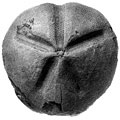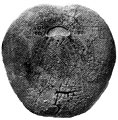The Echinoid Directory
Mundaster Soares & Devries, 1967 p. 16
| Diagnostic Features |
|
|---|---|
| Distribution | Upper Cretaceous (Cenomanian, Turonian) of Portugal. |
| Name gender | masculine |
| Type | Mundaster tentugalensis Soares & Devries, 1967, p. 16, 82, by original designation. |
| Species Included |
|
| Classification and/or Status |
|
| Remarks |
|




